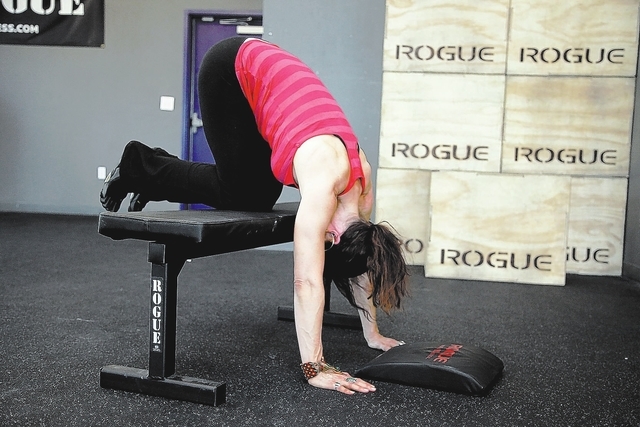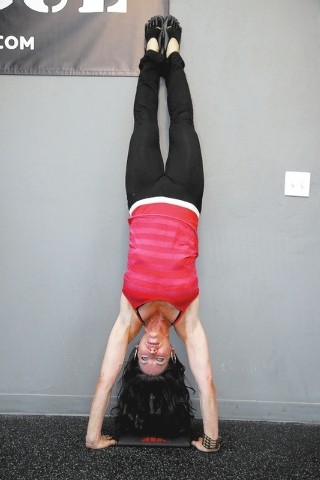Get a good education with handstand pushups
If you’ve read even this far, congratulations. You didn’t abandon today’s column just because the exercises appeared too complex in the pictures. Many advanced exercises have a number of smaller technique gems built into them.
Handstand pushups are one of those movements where you gain more from learning how to do them than you will from actually doing them. It is similar to obtaining a good education. Sure the road may be long and there are difficult parts that take time and effort, but in the end you have an achievement you can be proud of.
During your education you may have found a particular subject or instructor who had a significant impact on you. The impact of those lessons will be with you forever like gems in a treasure chest. Once you have the certificate that you have completed your education, you can apply it toward a higher goal.
I won’t sugarcoat it, handstand pushups are hard for a number of reasons. The first being that most people can’t press their body weight. Nor are they very proficient in an inverted position because of a lack of balance and/or a fear of falling. Another element is the core activation. A floppy core will not hold a person upright on their hands for an extended period of time.
Let’s break down the handstand pushup into its basic elements or gems. Its mechanics are identical to a shoulder press with a barbell. (See my earlier column on shoulder presses.) The hand position is similar as is the active shoulder principle. When pressing a barbell overhead, at the end range of motion when the bar is successfully pressed and being held overhead, the shoulders are in an “active” position. This means that even though the bar is overhead the shoulders are still pressing upward.
You can spot an active shoulder because it’s almost next to the ear. An active shoulder means the weight is not just jamming the humerus bone into the shoulder socket and searching for its own stability via your connective tissue and ligaments. Instead, you are holding your shoulder in the best possible position to support an overhead load. The end position for a handstand pushup is the same as a shoulder press. You’ll need to keep getting stronger on your shoulder presses so you can have the strength to begin attempting the handstand pushup. That is the first gem.
Core stability is a must for the handstand pushup. The core positioning for this movement is similar to the hollow body. See my earlier column on the hollow body for the specific breakdown. In short, the hollow body is a way of organizing the spine, hips, legs and arms for athletic movement. It gets its name from the crescent shape of the body having a “hollow” shape. Originally performed on the floor as a core exercise, it is the same form an athlete uses in the starting, press and at the end of the handstand pushup. Those holding a handstand will have a strong core to keep them there. That is another gem.
Position at the bottom of the handstand pushup can be tricky to master at first. The main reason is that you have to be somewhat inverted. If you are just starting, then no, you won’t be head over heels, but rather in a modified position. This way you can safely determine your positioning without the risk of a head or neck injury. See the modification featured in the paper and those online for the one that best suits your abilities.
For stability at the bottom or starting position of this movement we rely on the tripod principle. Three points in a triangle orientation allow for more stability than only two points or even three points in a straight line. The hands are positioned 6 to 12 inches from the shoulders and the head makes the third post of the tripod. Another gem.
I want to emphasize that the full weight of the body is not placed on the head and neck. The shoulders, though the arms are not extended, are still actively pressing upward to take tension away from the head and neck. The shoulders take the body’s load and the head just makes sure you don’t tip over. That’s a safety gem.
The forearm is vertical throughout the entire movement. If you notice it at an angle, then your press will not be as efficient as it should be. The elbows will be close to the body and not pointed out to the sides. If they are pointed out, this puts the shoulder in a weaker position for pressing. Remember, it is the same pressing position as a barbell press. Feel free to position your open hands on the floor or use some elevated bars used for doing deep pushups. Some like this variation because it feels more comfortable on the wrist. More gems to collect.
Working on the various principles of this one movement will not only make you rich with technique gems but also keep you busy for a while. Maybe your balance and starting position are good but you lack the strength to perform the movement. What if you are strong but can’t balance to save you from falling over. Mastering this movement will help to make you a well-rounded athlete.
Chris Huth is a Las Vegas trainer. He can be reached at 702trainer@gmail.com. If you are a Las Vegas trainer and want to share your love of fitness as a guest coach, please contact him. Consult your physician before beginning any exercise program.


























